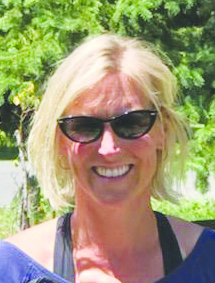
How a one-person organization is proving that educating a community ‘takes a village’
By Eric Valentine

In any typical year, especially during this time of year—budget season—income shortfalls and funding priorities and lists of must-haves versus nice-to-haves enter overdrive. So in a year when a 100-year pandemic is at the forefront of everything, those financial challenges can enter panic mode.
Enter organizations like Blaine County Education Foundation (BCEF) which, since 1992, has been securing funds—all through private giving—that has brought more than $2 million directly to teachers, students and schools in the Valley. Founded originally to raise funds for the creation of Founders Field in Hailey for school sports, the organization has expanded its impact across, essentially, all areas of need in the district. It provides grant money to individual teachers as well as entire schools. It establishes educational programs to help underachieving students as well as overachieving students, students from families with means and students from families without means. The COVID crisis made it pretty clear that BCEF’s role is not to merely fill funding gaps here and there. Its role can be the glue that keeps an entire school district together.
“COVID threw a curveball at schools and teachers. They weren’t sure what supplies or services were going to be needed to support students. We provided additional funding to help them keep students safe in the classroom and keep teachers connected to their students when they were at home,” explained Kristy Heitzman, BCEF’s executive director.
What follows is a summary of the programs BCEF provided Valley stakeholders, just this year. And something to keep in mind while reading through it is that the BCEF does it all with just one employee, Heitzman.
BCEF worked with Idaho Social Learning Center to provide social-emotional support to students at Wood River Middle School and Wood River High School. This support was recommended by social workers for students struggling with isolation anxiety due to hybrid learning. New academic support for students struggling with online learning was also provided. Through a gift from the Rixon and Cronin Charitable Fund, BCEF offered $500 scholarships per family in need, allowing students to work with individual tutors and tutoring agencies like The Space and Wisdom Nest.
Through BCEF Innovating Ideas Program, the Education Foundation awarded over $35,000 in teacher and schoolwide grants to enhance student learning online and in the classroom. These grants provided teachers and schools with additional materials above what a teacher has in the school budget to be creative and offer new ways to excite and educate their students. Over half of the teacher grants in the fall and spring were for online resources, due to COVID. For example, a WRHS class purchased online access to a Shakespeare book set. And the orchestra department at the WRMS purchased a curriculum to teach and play music virtually.
Due to COVID, BCEF was responsible for paying the bill to ensure all students had Internet service for online learning, BCEF purchased 330 webcams to ensure teachers could continue to educate students from any location if the 2020-21 school year was going to be solely online.
This year the Education Foundation expanded its after-school programs to provide additional academic support. At WRMS, the “whole-child” program provided school district staff support as well as one-on-one tutoring from The Space and active movement supervised by Idaho Base Camp.
“The longer after-school program not only supported students with academic needs but also allowed students to get outside and away from computer screens and move, which was critical after a year of isolation and extended screen time,” Heitzman said.
The Newer Normal
The Education fFundation is already looking ahead to the upcoming school year and assessing academic needs that students will have from not only the perennial “summer slide” but also following a year of part-time learning. BCEF will support academic programs at all eight public schools with two additional programs at Carey School and Hemingway STEAM School for elementary and secondary academic needs. In fact, late last month, Blaine County School District announced an unprecedented summer-school-and-beyond effort supporting 400 kids over the next two months wherein 11 summer programs using 40 school district personnel will “work with nonprofit partners to deliver a unique summer experience to students who need it most,” as trustee Dan Turner described it in a recent op-ed piece for the Idaho Mountain Express.
“The pandemic helped to bridge a stronger working relation between the district and BCEF. The district had a need to fill and a pressing timeline in which to make the greatest impact. It is easier for BCEF as a 501(c)(3) nonprofit to solicit donations and grants,” Heitzman said.
Nonetheless, the next phase of a new normal includes Heitzman making sure that efforts of the foundation do not become so normalized that they are expected as givens.
“Many people in our community did not know what we did or do, let alone who we are. I am the only employee and I need help to get the word out as to who we are and what we do,” Heitzman explained.
Adding to the challenge is that BCEF has restrictions on what exactly they can self-promote.
“We are a bit removed, since the majority of our assistance to students is confidential due to HIPAA [Health Insurance Portability and Accountability Act] laws,” Heitzman said.
For more information about becoming a donor or assisting BCEF efforts in other ways, Heitzman encourages community members to reach out at www.supportbcef.org where information on all the ways to help is available.
“We do have a few volunteer needs when it comes to assembling backpacks or if/when we do the scholarship fair again. We have been trying to work on a way to offer parents a way to support teachers during holidays and help fill a teacher’s wish list,” Heitzman noted. “These may be classroom supplies that are above the classroom budget and not a necessity but would be a luxury to enhance their students’ learning environment.”
BCEF by the Numbers
0 Federal, state or local government funding
1 Employees
2 Dollar amount educators can have auto-withdrawn from paychecks to donate to BCEF
22 Scholarships offered
24 Cost of a new backpack with supplies for students in need
46 Scholarships to graduating students
85 Percentage of “donor restricted” donations
250 Local residents in the donor pool
300 Backpacks given to students in need
300 Educators directly impacted
330 Webcams distributed for remote learning
3,000 Students directly impacted
2 million Dollars to teachers, students and schools since inception


